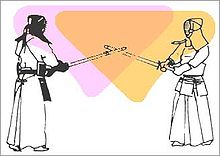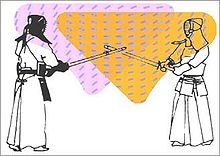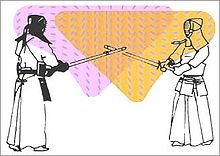
Kizeme
Encyclopedia



Seme (martial arts)
is a Japanese martial arts term for a kind of psychological pressure. The seme is the one inflicting something on to the uke. It is also an attitude meant to disrupt the opponents sense of confidence and resolution, prior to an attack....
when a kendo
Kendo
, meaning "Way of The Sword", is a modern Japanese martial art of sword-fighting based on traditional Japanese swordsmanship, or kenjutsu.Kendo is a physically and mentally challenging activity that combines strong martial arts values with sport-like physical elements.-Practitioners:Practitioners...
player has succeeded in causing shift in the mind (attention
Attention
Attention is the cognitive process of paying attention to one aspect of the environment while ignoring others. Attention is one of the most intensely studied topics within psychology and cognitive neuroscience....
) of the opponent. Kendoka at that stage takes the offensive mainly through Ki
Qi
In traditional Chinese culture, qì is an active principle forming part of any living thing. Qi is frequently translated as life energy, lifeforce, or energy flow. Qi is the central underlying principle in traditional Chinese medicine and martial arts...
, succeeding in disconcerting the opponent via KI-projection and at much higher skill level without visible gesture.
Kizeme is act of combat predominant in Kendo and should be regarded in contrast to ordinary levels of combat in which the awareness of the practitioners is limited to the most directly perceptible elements: speed, strength and sheer aggressiveness. The last can be used to delineate 3 levels of combat (see the 3 sketches on your right). These 3 levels were elegantly described in a compelling allegory by Issai Chosan (1727) Neko no Myojutsu ("The Cat's Eerie Skill"). Kizeme is depicted as the perfect skill in martial art, where non-violence is still an artifice that can be detected and exploited to dismiss the naturally embedded aggression in the ego
Budo
is a Japanese term describing martial arts. In English, it is used almost exclusively in reference to Japanese martial arts.-Etymology:Budō is a compound of the root bu , meaning war or martial; and dō , meaning path or way. Specifically, dō is derived from the Buddhist Sanskrit mārga...
and reach harmony – the state of Muga-mushin
Muga-mushin
is a compound term of muga and mushin. Muga literally means no-self and Mushin no-mind . What is negated is the empirical body-mind as an ontological independent state of existence. Muga and mushin point to the same thing, the state of egolessness, but from different perspectives...
.
An instructive attestation of kizeme can be seen in a demonstration kendo match at Noma dojo
Noma dojo
Noma Dojo is a privately owned kendo training hall, or dojo, located in Tokyo's Bunkyo ward close to Gokoku-ji. The original Noma Dojo was established in 1925 by Seiji Noma, founder of the Kodansha publishing house, but demolished by the company in late 2007 and replaced with a modern training...
by Moriji Mochida (ju
Japanese numerals
The system of Japanese numerals is the system of number names used in the Japanese language. The Japanese numerals in writing are entirely based on the Chinese numerals and the grouping of large numbers follow the Chinese tradition of grouping by 10,000...
-dan hanshi) during the Emperor's Cup (1940).

- "Swordsmanship is basically the exercising of the Life Force and, therefore, at the beginning of the study the Life Force is exercised by means of technique."
See also
- KendoKendo, meaning "Way of The Sword", is a modern Japanese martial art of sword-fighting based on traditional Japanese swordsmanship, or kenjutsu.Kendo is a physically and mentally challenging activity that combines strong martial arts values with sport-like physical elements.-Practitioners:Practitioners...
- MushinMushinMushin is a mental state into which very highly trained martial artists are said to enter during combat. They also practice this mental state during everyday activities. The term is shortened from mushin no shin , a Zen expression meaning the mind without mind and is also referred to as the...
- Muga-mushinMuga-mushinis a compound term of muga and mushin. Muga literally means no-self and Mushin no-mind . What is negated is the empirical body-mind as an ontological independent state of existence. Muga and mushin point to the same thing, the state of egolessness, but from different perspectives...
- Ma-ai
- BudōBudois a Japanese term describing martial arts. In English, it is used almost exclusively in reference to Japanese martial arts.-Etymology:Budō is a compound of the root bu , meaning war or martial; and dō , meaning path or way. Specifically, dō is derived from the Buddhist Sanskrit mārga...
- BushidoBushido, meaning "Way of the Warrior-Knight", is a Japanese word which is used to describe a uniquely Japanese code of conduct and a way of the samurai life, loosely analogous to the concept of chivalry. It originates from the samurai moral code and stresses frugality, loyalty, martial arts mastery, and...
- FudoshinFudoshinFudōshin is a state of equanimity or imperturbability...
- Zen Buddhism
- FeintFeintFeint is a French term that entered English from the discipline of fencing. Feints are maneuvers designed to distract or mislead, done by giving the impression that a certain maneuver will take place, while in fact another, or even none, will...
– similar concept in Western swordsmanship

